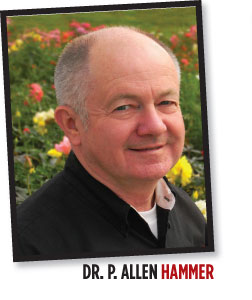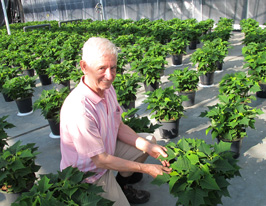10/26/2011
The Art of Plant Growing
Dr. P. Allen Hammer

During visits, growers often provide an interesting teaching moment and reality check for me. On a recent visit in British Columbia, Canada, we were discussing plant stress in relation to roots, water and environment. Simon Kruithof (pictured), the grower at Bevo Farms Ltd. said to me, “You simply need to feel the plant leaves to measure plant stress.”
Some would say you can’t “feel” plant stress. But you can feel plant leaf temperature and leaf turgidity. I’ve never really thought about using touch to measure plant stress, but it does make sense. Stressed plant leaves will be warmer and less turgid. I’ve told students good growers also develop the skill to “see” when plants need water. Plant leaves take on a “dull” appearance just before wilting. I’ve also seen growers not only look at plant roots, but also smell the plant root mass. Again it’s not something I’ve often considered, but it does make sense in detecting changes in the roots over time. Certainly a bad smell could suggest a root problem.
My learning in this case—good growers use all their senses to grow outstanding plants. In our present technological world, we too often rely on our fancy tools to make growing decisions. I’m not suggesting those new electronic tools are not extremely valuable and a must for every grower, but they’re only additional tools to help the grower. There’s the science of plant growing, yet there’s also a great deal of art in using that science to grow plants.
Outstanding growers have the art part of growing plants that I find is almost impossible to teach. Outstanding growers live the crop. They monitor the crop with sight, touch and even smell, on a continuous basis. Outstanding growers also use all the additional tools available to monitor the crop. Regular root medium testing is a part of the growing process; not simply a tool used to explain poor growth. Sticky cards are just as important as the application of pesticides. Reading the latest literature and even reviewing those old reference books is a part of the everyday life of the outstanding grower. I have a copy of the 1959 version of Florist Crop Production and Marketing by Kenneth Post that I still find useful to review from time to time.

Simon Kruithof of Bevo Farms Ltd. in British Columbia, Canada.
How many times do I walk into a greenhouse section with a grower and immediately detect too hot, too cold, too bright, too dark or too humid? Outstanding growers quickly feel the same thing and begin checking why the environment is not correct. Climate control computers, although absolutely essential, don’t grow plants. It’s true climate control computers become more sophisticated each year, but they still don’t have that grower’s eye to detect plant health. I don’t see the day when we will ever replace the outstanding grower with computers and sensors.
There’s an interesting balance between understanding the science and art of growing. In my experience, the most brilliant plant scientists can’t grow a quality plant even when given the very best growing tools available. They just don’t have the art part of plant growing.
It’s much easier to grow outstanding plants if one has the art part of plant growing; however, the very best growers have at least a little of the science part to add to their art of growing. But growers must be careful not to use too much science in their daily growing decisions. Some of the very worst growing decisions I’ve seen are made by growers trying to apply science to growing without looking at and understanding the plants in the greenhouse.
As I have said numerous times—outstanding growers spend more time in the greenhouse than in the office. Seeing, touching and smelling can’t be done at a distance from the plants.
GT
Dr. P. Allen Hammer is a retired professor of floriculture at Purdue University, West Lafayette, Indiana, and is now in product development and support for Dümmen USA.